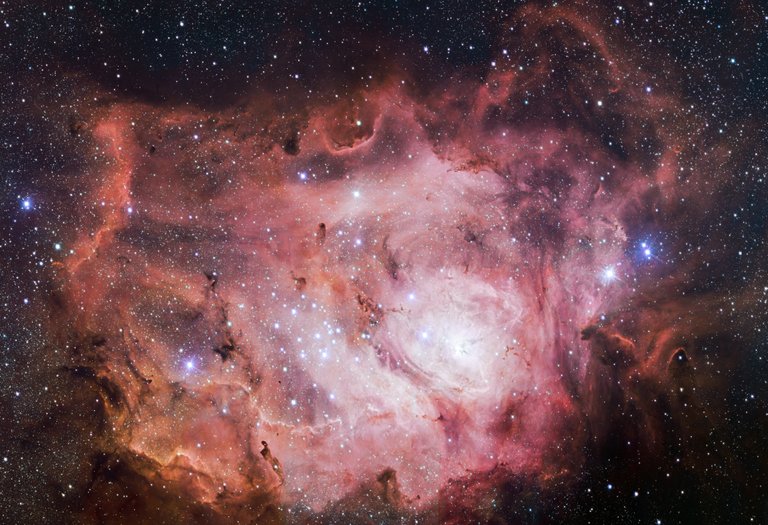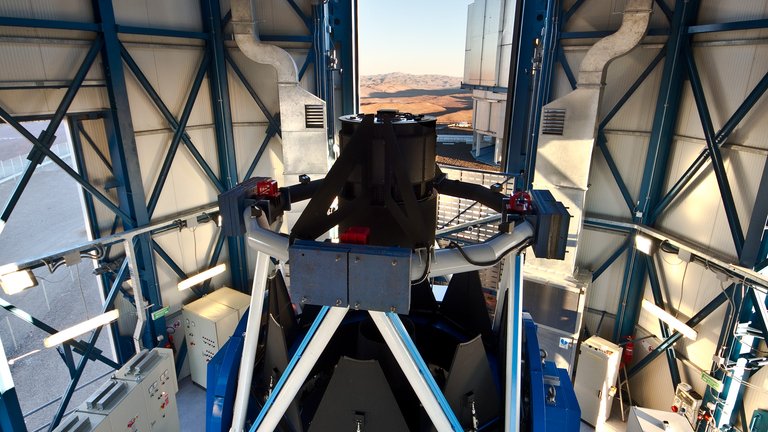As the title says, in this post I will write about Lagoon Nebula, also known as Messier object 8 - shortened M8 randomly chosen by @Kex.
The Lagoon Nebula is about 5200 light years away from Earth with dimension roughly about 140 by 60 light years. It represents a giant interstellar cloud in the constellation Sagittarius, composed primarily of hydrogen. Most of the hydrogen is ionized by radiation from the central "type O" star Herschel 36, also it is known as a big star-forming region (stellar nursery). Emission nebulae are localized regions of ionized gas which emits light in different wavelengths making all these colorful blends we often see in space Colours of nebulae depends on their chemical composition and central energy source - hot blue stars (type O or B).

Inside the nebula there are number of young open star clusters (for example: NGC 6530) and smaller nebulae. Small patches of nebulousity associated with newly born stars provided the first direct evidence of active star formation by accretion within the nebula.
M8 is also famous for having many of Bok globules which are dark, collapsing clouds of gas and dust on their way to form a protostar.

In case you are wondering what VST is and how it works, I will write a little bit about it.
VST stands for VLT (Very Large Telescope) Survey Telescope. Currently it is the largest telescope in the world designed for surveying the sky in visible light. This 2.6m telescope has joined the ESO VLT on Cerro Paranal.
.jpg)
Just like the VLT, the VST covers a wide-range of wavelengths from ultraviolet through optical to the near-infrared. But unlike largest telescope which can focus only on small portion of the sky at one time, the VST is designed to study and photograph large areas quickly and deeply.
The VST is made up of two mirrors. Primary mirror with a diameter of 2.61m and a smaller secondary mirror with a 93.8cm diameter. The telescope is also equipped with a single dedicated focal plane instrument omegaCAM, it is huge 16k x 16k pixels CCD camera with a total field view twice as broad as the full Moon. VST supports VLT with wide-angle imaging by detecting and pre-characterising sources, which the VLT Unit Telescopes can then observe further.
Being A SteemStem Member
On the large image link you can see the nebula is littered with Bok Globules. Fascinating to see the regions where new stars and solar systems are being born.
DISCLAIMER: dropahead Curation Team does not necessarily share opinions expressed in this article, but find author's effort and/or contribution deserves better reward and visibility.
to maximize your curation rewards!
with SteemConnect
12.5SP, 25SP, 50SP, 100SP, 250SP, 500SP, 1000SPDonate STEEM POWER to @dropahead
Do the above and we'll have more STEEM POWER to give YOU bigger rewards next time!
News from dropahead: How to give back to the dropahead Project in 15 seconds or less
Hi @svemirac ! I was pointed to your account through the BuddyUP service. Nice article, and best wishes to you!
Thank you and @buddyUP community! :) see you around!
Beautiful thing to see.